-
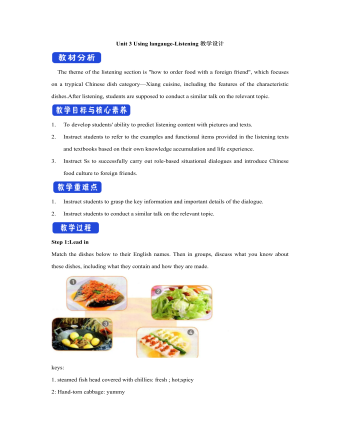
新人教版高中英语选修2Unit 3 Using langauge-Listening教学设计
1. How is Hunan cuisine somewhat different from Sichuan cuisine?The heat in Sichuan cuisine comes from chilies and Sichuan peppercorns. Human cuisine is often hotter and the heat comes from just chilies.2.What are the reasons why Hunan people like spicy food?Because they are a bold people. But many Chinese people think that hot food helps them overcome the effects of rainy or wet weather.3.Why do so many people love steamed fish head covered with chilies?People love it because the meat is quite tender and there are very few small bones.4.Why does Tingting recommend bridge tofu instead of dry pot duck with golden buns?Because bridge tofu has a lighter taste.5 .Why is red braised pork the most famous dish?Because Chairman Mao was from Hunan, and this was his favorite food.Step 5: Instruct students to make a short presentation to the class about your choice. Use the example and useful phrases below to help them.? In groups of three, discuss what types of restaurant you would like to take a foreign visitor to, and why. Then take turns role-playing taking your foreign guest to the restaurant you have chosen. One of you should act as the foreign guest, one as the Chinese host, and one as the waiter or waitress. You may start like this:? EXAMPLE? A: I really love spicy food, so what dish would you recommend?? B: I suggest Mapo tofu.? A: Really ? what's that?
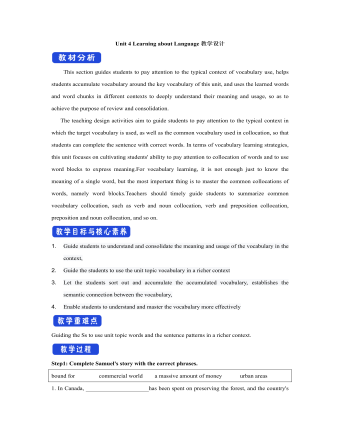
新人教版高中英语选修2Unit 4 Learning about Language教学设计
This section guides students to pay attention to the typical context of vocabulary use, helps students accumulate vocabulary around the key vocabulary of this unit, and uses the learned words and word chunks in different contexts to deeply understand their meaning and usage, so as to achieve the purpose of review and consolidation.The teaching design activities aim to guide students to pay attention to the typical context in which the target vocabulary is used, as well as the common vocabulary used in collocation, so that students can complete the sentence with correct words. In terms of vocabulary learning strategies, this unit focuses on cultivating students' ability to pay attention to collocation of words and to use word blocks to express meaning.For vocabulary learning, it is not enough just to know the meaning of a single word, but the most important thing is to master the common collocations of words, namely word blocks.Teachers should timely guide students to summarize common vocabulary collocation, such as verb and noun collocation, verb and preposition collocation, preposition and noun collocation, and so on.1. Guide students to understand and consolidate the meaning and usage of the vocabulary in the context, 2. Guide the students to use the unit topic vocabulary in a richer context3. Let the students sort out and accumulate the accumulated vocabulary, establishes the semantic connection between the vocabulary,4. Enable students to understand and master the vocabulary more effectivelyGuiding the Ss to use unit topic words and the sentence patterns in a richer context.
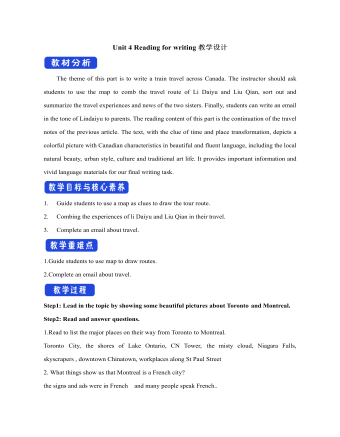
新人教版高中英语选修2Unit 4 Reading for writing教学设计
假定你是英国的Jack,打算来中国旅行,请你给你的中国笔友李华写一封信,要点如下:1.你的旅行计划:北京→泰山→杭州;2.征求建议并询问他是否愿意充当你的导游。注意:1.词数80左右(开头和结尾已给出,不计入总词数);2.可以适当增加细节,以使行文连贯。参考词汇:故宫 the Forbidden City;泰山 Mount TaiDear Li Hua,I'm glad to tell you that 'm going to visit China.First,I am planning to visit Beijing,the capitalof China,where I am looking forward to enjoying the Great Wall,the Forbidden City and somebeautiful parks.Then I intend to go to visit Mount Tai in Shandong Province.I've heard that it is one ofthe most famous mountains in China and I can't wait to enjoy the amazing sunrise there.After that,I amalso going to Hangzhou.It is said that it is a beautiful modern city with breathtaking natural sights,among which the West Lake is a well- known tourist attraction.What do you think of my travel plan? Will you act as my guide? Hope to hear from you soon.

新人教版高中英语选修2Unit 4 Using langauge-Listening教学设计
The theme of the listening section is " talking about scenery and culture along a journey."The part is designed to further lead the students to understand Canadian natural geography and social environment, and integrated into the cultural contrast by mentioning the long train journey from Beijing to Moscow routes. On this basis, the part activates students related travel experience, lets the student serial dialogue, guides the student to explore further the pleasure and meaning of the long journey, and Chinese and foreign cultural comparison.The part also provides a framework for the continuation of the dialogue, which is designed to provide a framework for students to successfully complete their oral expressions, and to incorporate an important trading strategy to end the dialogue naturally.1. Help students to understand and master some common English idioms in the context, and experience the expression effect of English idioms.2. Guide the students to understand the identity of different people in the listening context, and finish the dialogue according to their own experience.3. Instruct the students to use appropriate language to express surprise and curiosity about space and place in the dialogue, and master the oral strategy of ending the dialogue naturally.1. Instruct students to grasp the key information and important details of the dialogue.2. Instruct students to conduct a similar talk on the relevant topic.

新人教版高中英语选修2Unit 5 Learning about Language教学设计
The purpose of this section of vocabulary exercises is to consolidate the key words in the first part of the reading text, let the students write the words according to the English definition, and focus on the detection of the meaning and spelling of the new words. The teaching design includes use English definition to explain words, which is conducive to improving students' interest in vocabulary learning, cultivating their sense of English language and thinking in English, and making students willing to use this method to better grasp the meaning of words, expand their vocabulary, and improve their ability of vocabulary application. Besides, the design offers more context including sentences and short passage for students to practice words flexibly.1. Guide students to understand and consolidate the meaning and usage of the vocabulary in the context, 2. Guide the students to use the unit topic vocabulary in a richer context3. Let the students sort out and accumulate the accumulated vocabulary, establishes the semantic connection between the vocabulary,4. Enable students to understand and master the vocabulary more effectivelyGuiding the Ss to use unit topic words and the sentence patterns in a richer context.Step1: Read the passage about chemical burns and fill in the blanks with the correct forms of the words in the box.
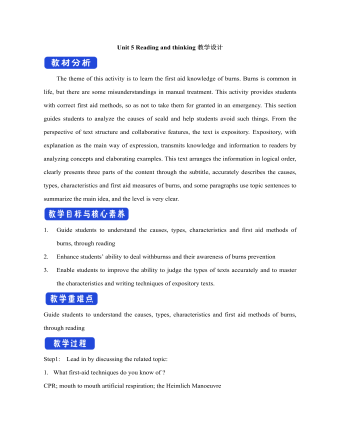
新人教版高中英语选修2Unit 5 Reading and thinking教学设计
The theme of this activity is to learn the first aid knowledge of burns. Burns is common in life, but there are some misunderstandings in manual treatment. This activity provides students with correct first aid methods, so as not to take them for granted in an emergency. This section guides students to analyze the causes of scald and help students avoid such things. From the perspective of text structure and collaborative features, the text is expository. Expository, with explanation as the main way of expression, transmits knowledge and information to readers by analyzing concepts and elaborating examples. This text arranges the information in logical order, clearly presents three parts of the content through the subtitle, accurately describes the causes, types, characteristics and first aid measures of burns, and some paragraphs use topic sentences to summarize the main idea, and the level is very clear.1. Guide students to understand the causes, types, characteristics and first aid methods of burns, through reading2. Enhance students’ ability to deal withburnss and their awareness of burns prevention3. Enable students to improve the ability to judge the types of texts accurately and to master the characteristics and writing techniques of expository texts.Guide students to understand the causes, types, characteristics and first aid methods of burns, through readingStep1: Lead in by discussing the related topic:1. What first-aid techniques do you know of ?CPR; mouth to mouth artificial respiration; the Heimlich Manoeuvre

新人教版高中英语选修2Unit 5 Using langauge-Listening教学设计
The theme of this section is to learn how to make emergency calls. Students should learn how to make emergency calls not only in China, but also in foreign countries in English, so that they can be prepared for future situations outside the home.The emergency telephone number is a vital hotline, which should be the most clear, rapid and effective communication with the acute operator.This section helps students to understand the emergency calls in some countries and the precautions for making emergency calls. Through the study of this section, students can accumulate common expressions and sentence patterns in this context. 1.Help students accumulate emergency telephone numbers in different countries and learn more about first aid2.Guide the students to understand the contents and instructions of the telephone, grasp the characteristics of the emergency telephone and the requirements of the emergency telephone.3.Guide students to understand the first aid instructions of the operators.4.Enable Ss to make simulated emergency calls with their partners in the language they have learned1. Instruct students to grasp the key information and important details of the dialogue.2. Instruct students to conduct a similar talk on the relevant topic.Step1:Look and discuss:Match the pictures below to the medical emergencies, and then discuss the questions in groups.
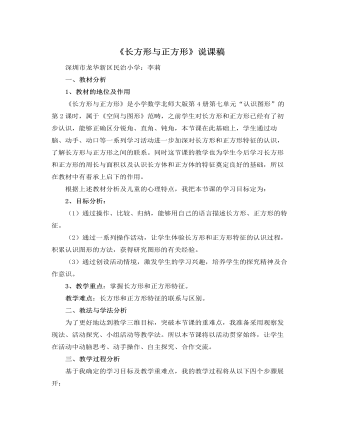
北师大版小学数学二年级下册《长方形与正方形》说课稿
(2)研究正方形:通过前面这个环节,学生已经掌握了研究长方形特征的方法,很自然地拿出一个正方形,通过看、数、量、折、小组讨论、展示交流等活动归纳出正方形的特征:正方形四条边都相等,四个角都是直角,这也是本节课的重点内容,但并不是难点,可由中下学生来完成,给他们以展示技能的机会。通过一系列的探究活动,学生的学习积极性已被调动,思维正处于活跃阶段,此时我把学生带到本节课的难点环节(3)想一想,长方形和正方形有什么相同点和不同点?对于学生的思考结果,老师并不急于回答,而是引导学生从长方形和正方形边和角的共同点去进行研究分析,让学生充分经历思考学习的过程,最后才巧妙地借助多媒体,直观地帮学生理解正方形是一个特殊的长方形,在这里多媒体化静为动,化抽象为直观,较好地帮学生突破了难点。至此,学生已经掌握了长方形、正方形的有关知识,此时,他们急于找到一块用武之地,以展示自我,体验成功,于是我把学生带入到“应用新知,理解提高”的环节。

新疆2016年中考历史真题试题(含答案)
13.(6分)在人类历史长河中,曾涌现出一大批著名的具有时代象征意义的历史人物。下列是中国近代史上的著名人物。关于其成就的叙述,请在正确项后面的空格里打“√”。错误的打“×” 序号人物 判断①魏源翻译《天演论》,激励人们“自强保种”,救亡图存,反对外来侵略 ②李鸿章在洋务运动中,参与创办江南制造总局,创办轮船招商局 ③梁启超参与发起公车上书,与他人合作创办《万国公报》,宣传维新变法思想 ④孙中山组建兴中会,建立中国同盟会;发起多次反清起义,创建中华民国 ⑤陈独秀在新文化运动中创办《青年杂志》;提出“民主”和“科学”的口号 ⑥张謇担任中国人修建的第一条铁路的工程师,设计出“人”字形铁轨
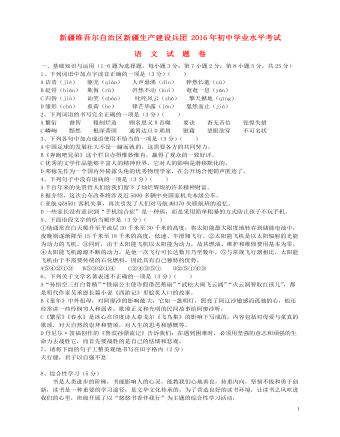
新疆2016年中考语文真题试题(含答案)
家乡的小砖房,一年四季潮湿漏雨。没有自来水,到街道唯一的自来水打水处提一分钱一桶的水。她长年不吃早饭,只为省一点钱给孩子们买点儿营养品,尽管他们仍然瘦弱多病。她经常在半夜三更惊醒,抱着发烧的孩子,深一脚浅一脚地奔向全县唯一的医院,然后整夜地陪着孩子打点滴。
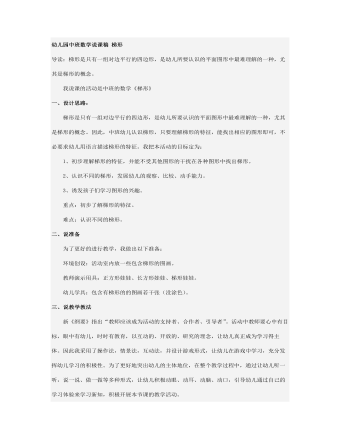
幼儿园中班数学说课稿 梯形
新《纲要》指出“教师应该成为活动的支持者、合作者、引导者”。活动中教师要心中有目标,眼中有幼儿,时时有教育,以互动的、开放的、研究的理念,让幼儿真正成为学习得主体。因此我采用了操作法,情景法,互动法,并设计游戏形式,让幼儿在游戏中学习,充分发挥幼儿学习的积极性。为了更好地突出幼儿的主体地位,在整个教学过程中,通过让幼儿听一听,说一说、做一做等多种形式,让幼儿积极动眼、动耳、动脑、动口,引导幼儿通过自己的学习体验来学习新知,积极开展本节课的教学活动。
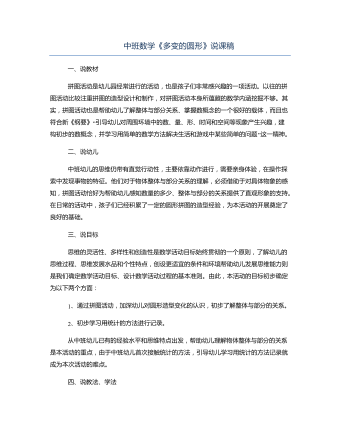
中班数学《多变的圆形》说课稿
拼图活动是幼儿园经常进行的活动,也是孩子们非常感兴趣的一项活动。以往的拼图活动比较注重拼图的造型设计和制作,对拼图活动本身所蕴藏的数学内涵挖掘不够。其实,拼图活动也是帮助幼儿了解整体与部分关系、掌握数概念的一个很好的载体,而且也符合新《纲要》“引导幼儿对周围环境中的数、量、形、时间和空间等现象产生兴趣,建构初步的数概念,并学习用简单的数学方法解决生活和游戏中某些简单的问题”这一精神。中班幼儿的思维仍带有直觉行动性,主要依靠动作进行,需要亲身体验,在操作探索中发现事物的特征。他们对于物体整体与部分关系的理解,必须借助于对具体物象的感知,拼图活动恰好为帮助幼儿感知数量的多少、整体与部分的关系提供了直观形象的支持。在日常的活动中,孩子们已经积累了一定的圆形拼图的造型经验,为本活动的开展奠定了良好的基础。

小班数学《认识三角形》说课稿
本教材选自《幼儿园教育教学安排意见》小班内容,认识三角形是幼儿几何形体教育的内容之一,幼儿的几何形体教育使幼儿数学教育的重点内容。幼儿学习一些几何形体的简单知识能帮助他们对客观世界中形形色色的物体做出辨别和区分。发展它们的空间知觉能力和初步的空间想象力从而为小学学习几何形体做些准备。小班幼儿在他们充分获得对圆形的感知和确认后,再让他们认识三角形的特征,这对发展幼儿的观察力、比较能力和空间概念具有重要意义。认识三角形是在认识圆形的基础上进行的。这就为比较圆形和三角形奠定了知识基础,有利于幼儿对三角形的感知和掌握。本节课的知识点就是三角形的特征。基于以上对教材的分析,结合幼儿的认知特点,确定以下教学目标:1、教幼儿知道三角形的名称和主要特征,知道三角形由3条边、3个角。2、教幼儿把三角形和生活中常见的实物进行比较,能找出和三角形相似的物体。3、发展幼儿观察力、空间想象力,培养幼儿的动手操作能力。
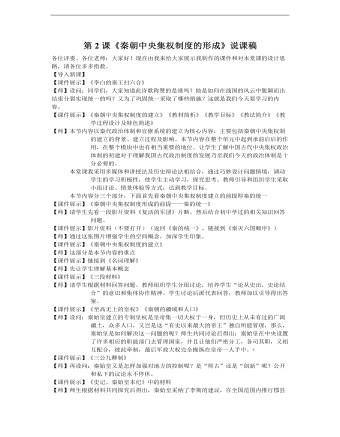
《秦朝中央集权制度的形成》说课稿
【课件展示】《秦朝中央集权制度的建立》《教材简析》《教学目标》《教法简介》《教学过程设计及特色简述》【师】本节内容以秦代政治体制和官僚系统的建立为核心内容,主要包括秦朝中央集权制的建立的背景、建立过程及影响。本节内容在整个单元中起到承前启后的作用,在整个模块中也有相当重要的地位。让学生了解中国古代中央集权政治体制的初建对于理解我国古代政治制度的发展乃至我们今天的政治体制是十分必要的。 本堂课我采用多媒体和讲授法及历史辩论法相结合,通过巧妙设计问题情境,调动学生的学习积极性,使学生主动学习,探究思考。教师引导和组织学生采取小组讨论、情景体验等方式,达到教学目标。
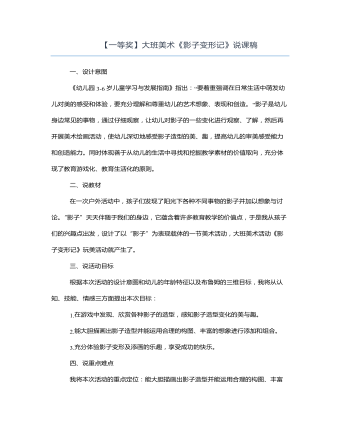
大班美术《影子变形记》说课稿
二、说教材在一次户外活动中,孩子们发现了阳光下各种不同事物的影子并加以想象与讨论。“影子”天天伴随于我们的身边,它蕴含着许多教育教学的价值点,于是我从孩子们的兴趣点出发,设计了以“影子”为表现载体的一节美术活动,大班美术活动《影子变形记》玩美活动就产生了。三、说活动目标根据本次活动的设计意图和幼儿的年龄特征以及布鲁姆的三维目标,我将从认知、技能、情感三方面提出本次目标:1.在游戏中发现、欣赏各种影子的造型,感知影子造型变化的美与趣。2.能大胆描画出影子造型并能运用合理的构图、丰富的想象进行添加和组合。3.充分体验影子变形及添画的乐趣,享受成功的快乐。
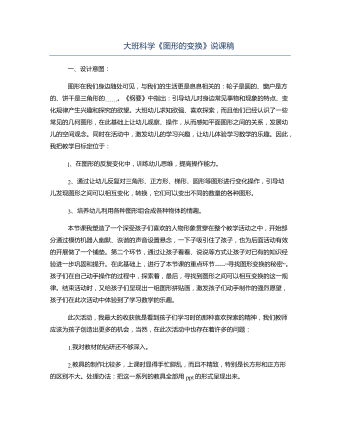
大班科学《图形的变换》说课稿
l、在图形的反复变化中,训练幼儿思维,提高操作能力。2、通过让幼儿反复对三角形、正方形、梯形、圆形等图形进行变化操作,引导幼儿发现图形之间可以相互变化,转换,它们可以变出不同的数量的各种图形。3、培养幼儿利用各种图形组合成各种物体的情趣。本节课我塑造了一个深受孩子们喜欢的人物形象贯穿在整个教学活动之中,开始部分通过模仿机器人幽默、诙谐的声音设置悬念,一下子吸引住了孩子,也为后面活动有效的开展做了一个铺垫。第二个环节,通过让孩子看看、说说等方式让孩子对已有的知识经验进一步巩固和提升。在此基础上,进行了本节课的重点环节-----“寻找图形变换的秘密”。孩子们在自己动手操作的过程中,探索着,最后,寻找到图形之间可以相互变换的这一规律。结束活动时,又给孩子们呈现出一组图形拼贴画,激发孩子们动手制作的强烈愿望,孩子们在此次活动中体验到了学习数学的乐趣。此次活动,我最大的收获就是看到孩子们学习时的那种喜欢探索的精神,我们教师应该为孩子创造出更多的机会,当然,在此次活动中也存在着许多的问题:
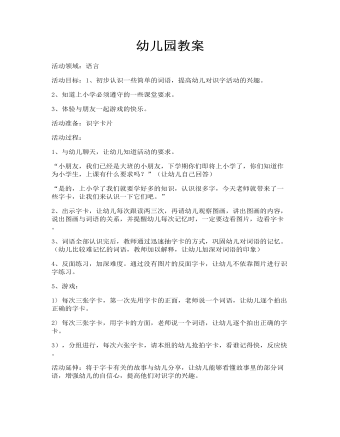
幼儿园教案
1、与幼儿聊天,让幼儿知道活动的要求。“小朋友,我们已经是大班的小朋友,下学期你们即将上小学了,你们知道作为小学生,上课有什么要求吗?”(让幼儿自己回答)“是的,上小学了我们就要学好多的知识,认识很多字,今天老师就带来了一些字卡,让我们来认识一下它们吧。”2、出示字卡,让幼儿每次跟读两三次,再请幼儿观察图画,讲出图画的内容,说出图画与词语的关系,并提醒幼儿每次记忆时,一定要边看图片,边看字卡。3、词语全部认识完后,教师通过迅速抽字卡的方式,巩固幼儿对词语的记忆。(幼儿比较难记忆的词语,教师加以解释,让幼儿加深对词语的印象)4、反面练习,加深难度。通过没有图片的反面字卡,让幼儿不依靠图片进行识字练习。
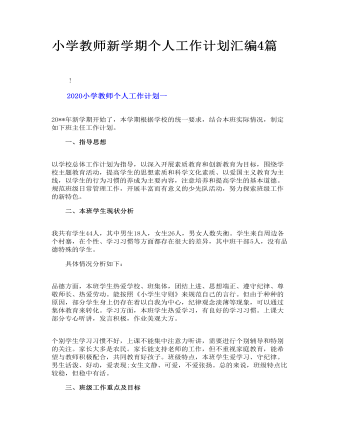
小学教师新学期个人工作计划汇编4篇
一、指导思想 以学校总体工作计划为指导,以深入开展素质教育和创新教育为目标,围绕学校主题教育活动,提高学生的思想素质和科学文化素质、以爱国主义教育为主线,以学生的行为习惯的养成为主要内容,注意培养和提高学生的基本道德。规范班级日常管理工作,开展丰富而有意义的少先队活动,努力探索班级工作的新特色。
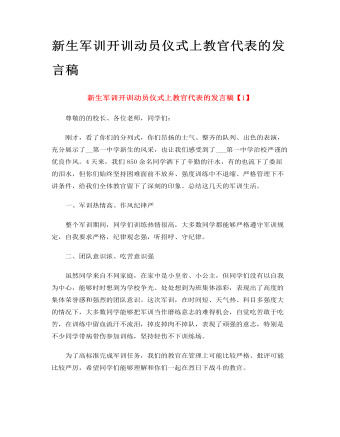
新生军训开训动员仪式上教官代表的发言稿
同学们,军训很苦,苦的让人不愿坚持,但军训也很甜,他可以增强我们的体魄,深化我们的情感,提升我们的思想境界。为此,我对同学们提出三点要求: 一、要求同学们要把自己当做一名真正的军人,严格要求自己,继承和发扬不怕苦、不怕累、艰苦奋斗的精神,克服困难、努力拼搏,圆满完成军训任务。 二、希望同学们在接下来的军训中,学会关心集体,关心他人,建立深厚的战友情、同学情,增强班级荣誉感。 三、希望同学们每天训练后要认真总结,及时深化心灵深处的精神力量,使之成为将来学习、生活和工作所需的宝贵财富。
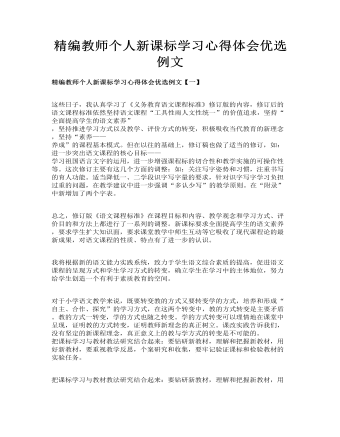
精编教师个人新课标学习心得体会优选例文
我将根据新的语文能力实践系统,致力于学生语文综合素质的提高,促进语文课程的呈现方式和学生学习方式的转变,确立学生在学习中的主体地位,努力给学生创造一个有利于素质教育的空间。 对于小学语文教学来说,既要转变教的方式又要转变学的方式,培养和形成“自主、合作、探究”的学习方式,在这两个转变中,教的方式转变是主要矛盾。教的方式一转变,学的方式也随之转变。学的方式转变可以理情地在课堂中呈现,证明教的方式转变,证明教师新理念的真正树立。课改实践告诉我们,没有坚定的新课程理念,真正意义上的教与学方式的转变是不可能的。把课标学习与教材教法研究结合起来:要钻研新教材,理解和把握新教材,用好新教材,要重视教学反思,个案研究和收集,要牢记验证课标和检验教材的实验任务。

